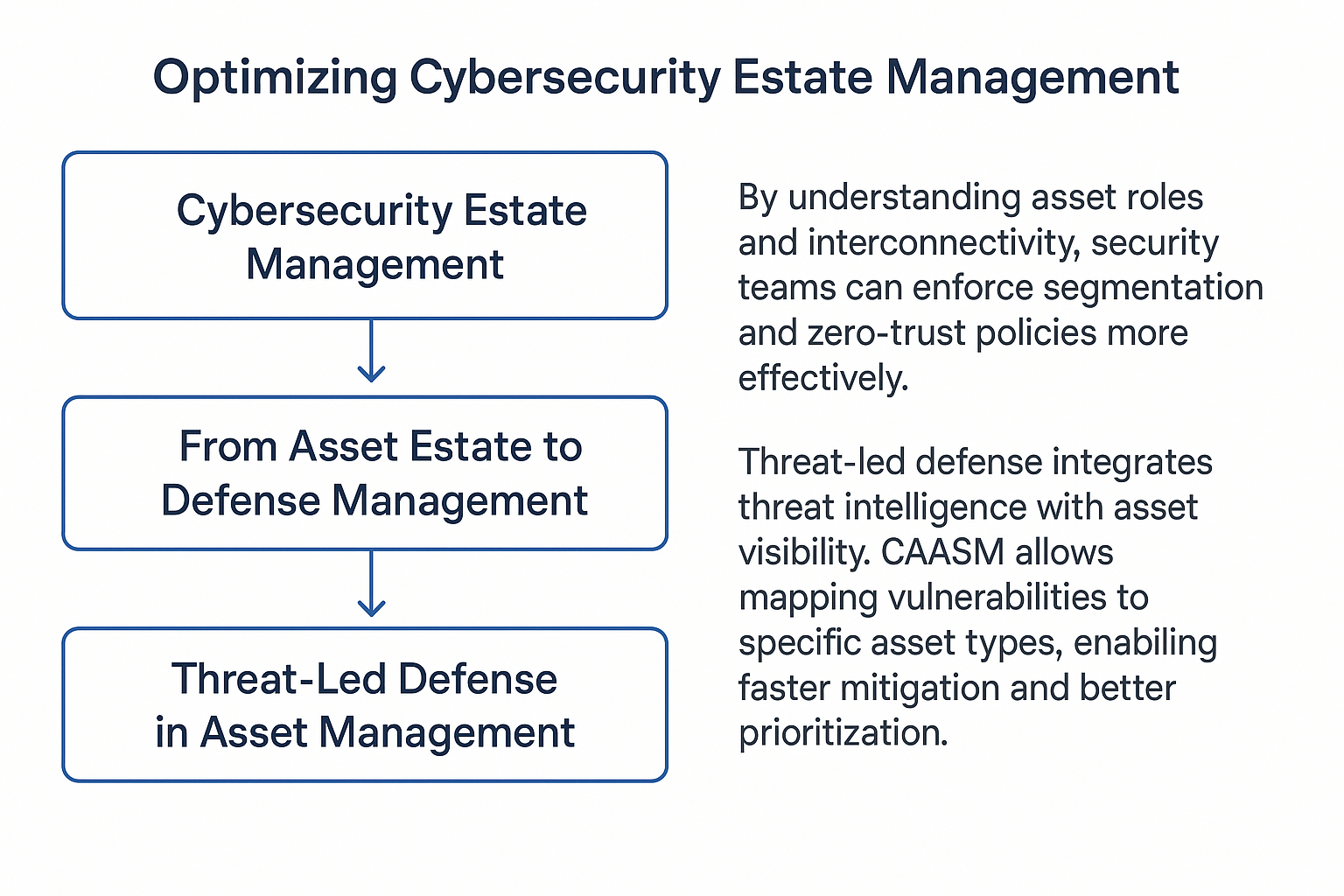Introduction to CAASM (Cyber Asset Attack Surface Management)
CAASM enables organizations to understand and control their cybersecurity estate by delivering real-time insights into known and unknown assets, managed and unmanaged endpoints, and the relationships between them.
In an era where cyber threats are evolving rapidly, CAASM provides the necessary tools for asset discovery, classification, inventory, and continuous risk mitigation.
The Importance of CAASM (Cyber Asset Attack Surface Management)
As enterprises digitize, the need for robust cybersecurity asset management becomes mission-critical. Assets now include physical devices, virtual machines, containers, IoT and OT systems, user identities, and software applications. A lack of visibility into these assets leads to vulnerabilities that can be exploited by threat actors.
“Unknown” assets are those that exist within an environment but are not recognized or documented by the organization, making them invisible to security teams and highly vulnerable to exploitation. In contrast, “unmanaged” assets are known but not actively maintained or governed by standard IT or security processes, leaving them exposed due to lack of oversight.
While both types increase the attack surface, unknown assets pose a risk due to lack of visibility, whereas unmanaged assets pose a threat due to lack of control.
Risks of Known and Unknown Assets
Cybersecurity failures often stem from incomplete inventories. Unmonitored or unrecognized assets—commonly referred to as “unknown assets”—can harbor outdated firmware, weak encryption, or default credentials, making them soft targets for attackers. Even known assets become threats if not regularly maintained or patched.
Impact of Suspicious and Unmanaged Assets
Suspicious, rogue, or unmanaged assets bypass standard security controls. These may include unauthorized devices introduced via shadow IT or obsolete systems forgotten in legacy infrastructure. Their unmanaged nature increases the attack surface, undermines security posture, and complicates compliance efforts.

Asset Discovery and Identification Techniques
Asset discovery is the backbone of any effective CAASM strategy. Traditional tools rely on Configuration Management Databases (CMDBs), which are often outdated or incomplete. Modern CAASM solutions go further by actively scanning and correlating asset data from across the digital estate.
Cloud vs. On-Prem Asset Discovery
Discovery in cloud and multi-cloud environments demands API-level integration with providers like AWS, Azure, and Google Cloud. For on-premise and legacy systems, agent-based and agentless scans are often necessary. Hybrid environments benefit from platforms that can merge these methods seamlessly.
| Environment | Discovery Method | Key Challenge |
|---|---|---|
| On-Prem | Agent/Agentless Scans | Device diversity & segmentation |
| Cloud | API Integration | Ephemeral instances & misconfigurations |
| Multi-Cloud | Correlation Engines | Asset duplication, normalization |
| Hybrid | Combined Approach | Data consistency & integration |
Challenges in Multi-Cloud and Hybrid Environments
The proliferation of multi-cloud strategies leads to data fragmentation. Assets are scattered across environments with differing naming conventions, tags, and metadata. Effective CAASM solutions normalize this data for consistency and integrate it into a single, cohesive inventory.
Effective Asset Classification and Inventory Strategies
Asset classification categorizes assets based on criticality, type, and business function. CAASM tools automate this process, enabling better risk prioritization. A well-maintained asset inventory is essential for patch management, vulnerability detection, and audit readiness. Real-time classification also informs risk-based threat modeling.
Asset Reconciliation: Bridging the Gap with CMDBs
Traditional CMDBs lack real-time visibility and require manual updates. CAASM enhances CMDB utility by serving as a live data source that continuously updates asset records.
Integrating Configuration Management Databases (CMDBs)
Through API connectors and data normalization, CAASM feeds accurate asset data into CMDBs. This improves the effectiveness of ITSM, ITAM, and SOAR workflows while ensuring consistency across cybersecurity operations.
| CMDB Challenge | CAASM Resolution |
|---|---|
| Stale Records | Real-time updates from continuous scans |
| Missing Metadata | Data enrichment via automated discovery |
| Manual Input Errors | Automated reconciliation and validation |
Optimizing Cybersecurity Estate Management
Cybersecurity Estate Management refers to the holistic governance of an organization’s digital infrastructure. With the attack surface expanding, organizations require CAASM to maintain a dynamic view of the estate and enforce policies based on risk.
From Asset Estate to Defense Management
By understanding asset roles and interconnectivity, security teams can enforce segmentation and zero-trust policies more effectively. This translates into Threat Led CyberSecurity strategies, where controls align with asset exposure levels.
Threat-Led Defense in Asset Management
Threat-led defense integrates threat intelligence with asset visibility. CAASM allows mapping vulnerabilities to specific asset types, enabling faster mitigation and better prioritization.

Real-Time Asset Visibility and Monitoring
The ability to monitor assets continuously is what differentiates CAASM from legacy inventory tools. Real-time insights ensure that assets are not only discovered but also tracked for behavior anomalies and security posture changes.
Continuous Monitoring for Managed and Unmanaged Assets
Managed assets follow standard security controls and update cycles, whereas unmanaged assets (e.g., personal devices, rogue systems) require special attention. CAASM leverages agentless detection, credential-free recognition, and network fingerprinting to identify all endpoints regardless of type or location.
Enhancing Security with Comprehensive CAASM Solutions
Comprehensive CAASM platforms integrate with other cybersecurity solutions like SIEM, EDR, and ITSM tools to create a unified defense framework. They automate the discovery, assessment, and remediation cycles.
Automation and Risk-Based Remediation
Automated workflows enable organizations to assign ownership, trigger patching, and update inventories with minimal manual intervention. Risk scoring mechanisms (e.g., TruRisk™) provide prioritization based on threat impact, not just vulnerability count.
Reducing Exposure through Asset Management
By eliminating obsolete, duplicate, or unused assets, CAASM directly contributes to attack surface reduction. This results in stronger incident response, compliance, and overall cyber resilience.
Key Benefits of CAASM (Cyber Asset Attack Surface Management) Implementation
CAASM doesn’t just improve security—it optimizes IT and business operations. The following benefits are commonly realized:
- Unified view of cloud, multi-cloud, and on-prem infrastructure
- Reduced risk from shadow IT and unknown devices
- Real-time inventory and configuration tracking
- Enhanced compliance reporting and governance
- Faster mean-time-to-remediate (MTTR)
Business Continuity and Regulatory Compliance
Continuous visibility and automated compliance dashboards ensure that regulatory frameworks (e.g., NIST, ISO, GDPR) are met, minimizing legal and financial risks.
Improved Risk Posture and Incident Response
With a real-time view of vulnerable assets, incident response teams can act faster, isolate risks, and prevent lateral movement within networks.
Barriers to CAASM Adoption and How to Overcome Them
While CAASM offers tremendous value, several adoption barriers exist:
- Budget constraints due to overlapping tools
- Resistance from IT teams unfamiliar with CAASM’s purpose
- Scalability challenges in environments with millions of assets
- Limited support for IoT and OT in legacy solutions
Overcoming these challenges requires stakeholder education, proof-of-concept trials, and selecting vendors with extensible integration capabilities.
Best Practices for Implementing a CAASM Strategy
Implementing CAASM should be phased and strategic. Start with critical asset classes and expand coverage gradually.
Checklist for CAASM Deployment
- Define objectives and KPIs
- Inventory high-value and external-facing assets
- Integrate CAASM with CMDB and SIEM platforms
- Enable continuous discovery and reconciliation
- Establish automated remediation workflows
Recommendations for CIOs and CISOs looking to implement CAASM
- Prioritize platforms with agentless and API-first architecture
- Ensure support for cloud, multi-cloud, and on-prem environments
- Select tools that enrich CMDB and ITSM with real-time asset metadata
- Align CAASM strategy with broader Threat-Led CyberSecurity goals
Conclusion: Strengthening Your Cybersecurity Defense Management
Cyber Asset Attack Surface Management is no longer a “nice-to-have”—it’s a core pillar of enterprise cybersecurity. By adopting CAASM, organizations can ensure full visibility, reduce their risk exposure, and transform their cybersecurity defense management from reactive to proactive. From asset discovery to automated remediation, CAASM is the key to building a resilient, secure, and compliant digital estate.












